|
Getting young students to put in the needed hours of practice to achieve skill in musicianship can be challenging for parents and teachers in the best of times. During a period of social crisis and upheaval of familiar routines, the task becomes even more daunting. With social distancing, quarantines, and society-wide lockdowns becoming a feature of life during the coronavirus pandemic, kids may be learning virtually, with a family member’s guidance, or even on their own. Regardless of the situation, experts in music teaching and human psychology have a few tips that can prove helpful in both normal and abnormal circumstances. 1. Provide the comfort of a routineA sudden lack of routine is confusing for children, particularly when coupled with a natural fear of the unknown. Parents need to provide as much of a sense of structure and normalcy as possible, pediatric psychologists say, as a routine tends to foster a greater sense of stability and security. It also helps in keeping frustration and boredom at bay. Experts recommend setting up a daily schedule that works for everyone in the household and sticking to it (to the extent that any of us can at present). Although it may be tempting to let kids oversleep when school is out, it’s better in the long run to boost their ability to focus and stay on task with a regular bedtime and wake-up time. Parents should also strive to work in scheduled meals, homework time, playtime, and of course, music practice time. 2. Respect a child’s agencyOther tips from the time before social distancing remain good advice, particularly this one: Give your child a sense of agency and control over his or her music practice. Let kids help decide on the right number of practice hours at this time, as well as when practice needs to take place. Nagging and punishment—especially when everyone is under stress—is seldom if ever effective in encouraging attentive practice, and it can discourage a child’s engagement with music lessons. You can help provide perspective by helping kids research how successful musicians of the past and present have kept up their practice schedules. It also helps to offer a special reward when your child sticks to a self-regulated schedule. 3. Foster respect for the giftSpur inspiration by showing children the musical gift they possess. Help them understand that nurturing that gift is both an obligation and a privilege that relatively few people enjoy. Great teachers in all fields of music do everything they can to instill in their students the idea that music is a gift that needs to be shared and that they owe it to themselves and others to allow that gift to blossom through diligence and determination. If you’ve had your own struggles with staying focused and on task, share those with your child, and try to be honest about addressing regrets for less-than-diligent efforts as well as examples of achievement. 4. Build in healthy physical breaksWhile you may not be able to maintain a picture-perfect lifestyle right now, remember that there are plenty of things you can do to help kids burn off excess energy and stay physically active. In most communities under lockdown, healthy outdoor exercise is allowed and encouraged, provided it does not involve contact sports or violate safe social distancing requirements. Unless someone at home is ill, it should be safe to take walks, runs, and bike rides. Additionally, this physical activity will set kids up to be more focused when it comes time for settling down to indoor music practice. Another option: Bust out some lively music at home and let kids dance all over. 5. Break for screen time—and musicWhile many families put strict limits on children’s screen time, experts say it won’t hurt—and may provide additional distraction and comfort—to relax those limits in the present crisis. In allowing for more screen time, try to suggest some fun and educational websites that offer opportunities for music appreciation. YouTube can be a minefield of inappropriate content, but several enriching and deeply moving musical performances are widely available on the platform. These include thoughtfully produced, socially distanced performances by renowned individuals and ensembles. Cellist Yo-Yo Ma, for example, offers a #SongsOfComfort series in which he plays Antonín Dvořák’s “Going Home” theme and other masterpieces especially suited to our present moment. Another example of inspiring and socially distanced masterworks includes the Metropolitan Opera’s At-Home Gala performance of “Va, pensiero,” the poignant anthem sung by the Hebrew slaves in Giuseppe Verdi’s Nabucco. The Met’s April 25 broadcast of this and other performances also shows the inspiring level of technical creativity human musicians and conductors can achieve when circumstances call it forward. Each musician’s and singer’s performance was recorded individually and united on one soundtrack and screen, anchored by conductor Yannick Nézet-Séguin in his living room. The Met’s other At-Home Gala performances include Jules Massenet’s "Méditation" from the opera Thaïs, the Intermezzo from Pietro Mascagni’s Cavalleria Rusticana, and the aria “Ombra mai fù” from Serse by George Frideric Handel. This last performance is particularly meaningful since it was a tribute to Met violist and youth orchestra conductor Vincent Lionti, who died of complications from the coronavirus on April 4. 6. Go easy on kids—and yourselfFinally, experts in all fields of family psychology advise being gentle and compassionate toward yourself and your child. Every day is a new day, and if your carefully planned routines are only aspirational on certain days, it’s to be expected sometimes.
Adults have lost a lot of social anchors themselves, and the more love and understanding families can show one another in time of crisis, the more it will strengthen relationships—as well as everyone’s ability to achieve as musicians and as human beings—now and long after social distancing has served its needed purpose. The artistry shown in a violin performance is highly individual and subjective. Most musicians can achieve competence in playing the instrument. However, if you have shown the interpretative sensitivity, technical virtuosity, charm of personality, or striking originality of expression that moves them into a class by themselves. Here are short biographies of four outstanding performers whose dedication and talent have moved audiences over the centuries. 1. Niccolò Paganini 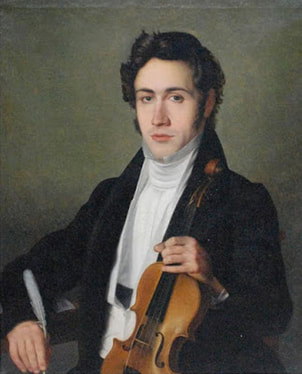 Image courtesy Wikipedia Image courtesy Wikipedia Niccolò Paganini (1782 - 1840) is perhaps the first musician who can be considered a virtuoso of the instrument. He remains venerated by violinists and the general public alike. His charisma garnered him a cult-like following during his lifetime. His impact on the entire later history of how the violin is played, and how violinists perform on stage, cannot be overestimated. Born in Genoa, Italy, Paganini debuted as a performer the year he turned 11. As a young man, he toured Lombardy while also getting entangled in a number of romantic escapades. At one point he pawned his violin to settle his gambling debts. Biographers record the story that a French merchant then gave him a Guarneri in recognition of his talents. Paganini was also a gifted composer. His 24 Capricci for Solo Violin remain staples of the classical repertoire. From 1828 onward, he undertook tours of England, Scotland, and the Continent, amassing a personal fortune in the process. It was Paganini who commissioned the great French composer Hector Berlioz to create the symphony Harold in Italy, although the virtuoso considered the work unchallenging and never performed it. Paganini’s technique called on a wide-ranging scheme of harmonics and his talent for playing pizzicati. He made up his own innovative methods for tuning and fingering, and displayed a genius for improvisation. A whole raft of legends grew up around this Romantic-era figure, including one that says he got his extraordinary musicianship thanks to a deal with the devil. 2. Jascha Haifetz Jascha Heifetz (1901 - 1974) started his career as a violinist when he was 5 years old. He was soon playing in Berlin, Prague, and Warsaw and performing complex works that included Tchaikovsky’s Violin Concerto. At age 16, he enjoyed a spectacular debut at Carnegie Hall. The young refugee from Lithuania gave a performance that one music historian has called “like electricity.” Heifetz showed not only an almost unbelievable level of technical proficiency in his instrument, but an immense warmth of feeling and interpretation to match. Heifetz obtained United States citizenship at age 24 and thereafter toured the world. He commissioned a number of violin concertos and himself became a noted transcriber of great works by Bach and Vivaldi into pieces for the violin. Later in life, he taught at the University of Southern California, Los Angeles. Heifetz was one of the undisputed 20th-century masters of the violin. PBS showcased his legacy in a special broadcast in its American Masters series that called him “God’s Fiddler.” 3. Itzhak PerlmanItzhak Perlman, born in 1945, often tops critics’ lists of the greatest living classical violinists. He has an instantly recognizable bold and exuberant technique. He has remarked that the best technique doesn’t reside in the ability to elicit notes rapidly from the instrument, but in the capacity to evoke rich and surprising tone and color. A renowned teacher and composer as well as a performer, the Israeli-born Perlman has become a pop culture icon. Between the years 1977 and 1995, he racked up 15 Grammy Awards. He is also the recipient of a U. S. Medal of Freedom, a Kennedy Center Honor, and numerous other accolades. Perlman has also made appearances on the children’s educational television show Sesame Street. In a 1981 segment, he movingly demonstrated the difference between “easy” and “hard,” walking onto the stage using crutches (the result of childhood polio) before taking up his violin to play a lively passage. Perlman’s focus on teaching and philanthropy is exemplified in the Perlman Music Program he and his wife established in the 1990s. The program provides training and support to teen string musicians of exceptional promise. 4. Hilary Hahn Hilary Hahn, born in 1979, is known for her dynamic, sensitive interpretations of works by a varied list of composers from Bach to Stravinsky. She began studying the Suzuki method at age 4, made her orchestral debut at age 11 with the Baltimore Symphony Orchestra, performed on her first classical recording at 16, and has gone on to receive numerous international awards, including two Grammys before she turned 30.
In 2015, she received her third Grammy for her album In 27 Pieces: The Hilary Hahn Encores. In hundreds of live solo performances, she has been accompanied by the world’s premier orchestras. Hahn has spent her career making classical music accessible to younger audiences. She has performed for films and with alternative rock groups, and has cut a string of successful classical albums, always with a warm and personal approach. Hahn’s popular social media accounts, a signature component of her educational mission, feature running commentary from the point of view of her violin case as it travels with her around the world. In 2010, American composer Jennifer Higdon received a Pulitzer Prize for the violin concerto she wrote specifically for Hahn. Higdon created a piece combining technical virtuoso flourishes with deep, meditative flow, which she tailored to Hahn’s immense lyrical range and ability to negotiate complex changes in meter. Every young musician deserves to know more about the fascinating talents who came before them, and today’s publishers offer a rich variety of musical biographies designed to captivate and inspire children. Read on to learn how the recent spate of musician biographies are standing out. Getting to know great talent in a whole new wayThe Who Was/Who Is series of junior biographies makes learning fun with clear, easy-to-read text and illustrations bursting with pizzazz. This series, published by Penguin Workshop, has quickly achieved cult status among elementary-age readers, as well as teachers, librarians, and parents. While many of the biographies in the series cover presidents, scientists, and explorers, many others focus on noted singers, composers, and instrumentalists. For example, young readers can explore the life of Aretha Franklin, a gospel singer born in segregated Memphis, Tennessee, who used her talent to go on to become the one and only Queen of Soul. Franklin exerts a cultural and artistic influence that continues to transcend her death in 2018. Most of the biographies of musicians in this series cover talent from the second half of the 20th century and beyond. Bob Marley, Dolly Parton, Selena, Pete Seeger, Stevie Wonder, and the Beatles are only a few of the figures in popular music whose biographies join Franklin’s. But the series additionally explores a bit of the more-distant musical past with a book on the phenomenal jazz trumpeter Louis Armstrong, who rose to fame in the 1920s. It also transports readers to the world of classical music through its biography of composer Wolfgang Amadeus Mozart. Each of these titles gives a wide-ranging overview of its subject’s life and work, providing all the basic information a student would need for a beginning report. An added element of fun in this series comes from the eye-popping cover art—each book’s subject is depicted in caricature with an oversized head set against a colorful, action-packed background. So immediately recognizable are these covers that the books are affectionately known as the “Big Head” biographies. Learning about composers can be funThe Getting to Know the World’s Greatest Composers series, published through Scholastic’s Children’s Press imprint, offers light-hearted but informative looks at some of the great Baroque, classical, and contemporary masters. Written for the grade-school market, this series combines primary source reproductions of historical documents with engaging, color-packed cartoons. The mix of humor with report-ready information and stirring anecdotes about the composers’ lives makes the entire series a winner. Johann Sebastian Bach, George Frideric Handel, Ludwig van Beethoven, Pyotr Ilyich Tchaikovsky, George Gershwin, and Duke Ellington are only some of the composers represented in this series, each with their own 40-page biography. Turbulent times unite a young pianist and a presidentBooks on individual musicians can fascinate both children and adults, as evident by the recent spate of creatively designed, richly illustrated biographies. Many focus on the highly talented black, brown, and female composers, singers, and musicians that were previously neglected by history and who are now receiving much-deserved attention as our understanding of their contributions fills in the gaps in humanity’s diverse musical heritage. In Dancing Hands: How Teresa Carreño Played the Piano for President Lincoln (Atheneum, 2019), renowned author Margarita Engle teams up with award-winning illustrator Rafael López to present the true story—in lilting free verse and fanciful washes of color—of a child prodigy on piano who became a young composer and a popular performer in her native Venezuela. In 1862 revolution forced her parents to escape with 8-year-old Teresa to the United States, where very few people spoke her language. And this new homeland was fighting its own divisive war. But Teresa’s love of music sustained her. In the US, people called her “Piano Girl,” and she became famous for her ability to interpret any genre of music. When she was only 10 years old, Teresa received President Abraham Lincoln’s invitation to play at the White House. The book itself, according to Kirkus Reviews, offers a “concerto for the heart,” as Teresa tries to lighten the burdens of the wartime president through her art. A sweet voice too soon silencedIn Harlem’s Little Blackbird: The Story of Florence Mills (Random House, 2012), the acclaimed author-illustrator duo of Renée Watson and Christian Robinson bring the story of one of the world’s greatest singers to life. Florence Mills was the daughter of former slaves. Born just before the turn of the 20th century, she first graced the stage at age 5 and became a celebrated performer in Harlem nightclubs and on Broadway. Known for her sweet, soft voice, she captivated audiences until her untimely death at 31. In 1926 Florence won a lead role in Blackbirds, a musical that would take her on an international tour and provide her signature tune (“I’m a Little Blackbird Looking for a Bluebird”) and her nickname. But Florence also experienced the deep racism endemic to the era. During her short life, she fought for the rights and creative freedoms of African-American performers, and generally supported the cause of civil rights. So beloved was she that, after her death from an infection following surgery, tens of thousands of mourners filled the streets of New York City outside the church where her funeral took place. The book offers a moving and gorgeously illustrated account of how this multi-talented performer pursued her dreams, thrived despite injustice, and touched the lives of millions. A modern-day personification of New Orleans’ exuberance “Trombone Shorty” needs no introduction to many contemporary music lovers. A New Orleans-born trombone player, bandleader, singer-songwriter, and New Orleans Jazz Fest headliner, 34-year-old Troy Andrews became a maestro of the horn as a young child. His skills are so renowned that a popular club in his Tremé neighborhood was named Trombone Shorts in his honor when he was just 8.
Andrews picked up his nickname early, when he was still only half the size of his instrument. His nickname serves as the title of his picture book autobiography, illustrated by award-winner Bryan Collier and published in 2015 by Harry N. Abrams. Andrews’ book welcomes readers with “Where y’at?” in true New Orleans fashion. He details his early life as a budding African-American musician in a family of musicians, as well as how he grew up making and playing his own instruments out of items from junk heaps until he started patiently learning how to play a dilapidated old trombone he found one day. Andrews’ true story, coupled with Collier’s dynamic pictures that embody the rhythms of New Orleans jazz, will provide plenty of inspiration to children and grown-ups alike. On June 7, 2020, Radio City Music Hall in New York will host the 74th annual Tony Awards, honoring Broadway’s best. This year will be the 20th time the Tonys have been presented at Radio City. Radio City is one of the world’s most exciting and glamourous venues for performing arts. Events hosted there include vaudeville, movies, musical concerts, awards shows, and special programs of all kinds. As a result, it has become a beloved icon of American life, and a landmark site for visitors to New York. Here are nine of the most interesting facts you may not know about it: 1. It opened during the Great Depression.Radio City Music Hall opened on a rainy night in New York City on December 27, 1932. That a new theater and entertainment venue of its size would open in the depths of the Great Depression testifies to the longing of people, even in discouraging or desperate circumstances, to find comfort and encouragement in the power of high-quality music and performance. The venue was specifically designed to be a kind of people’s entertainment palace, a place that could bring beauty into everyday lives at an affordable admission price. 2. It has hosted over 300 million visitors since its opening.Opening night saw thousands of people waiting to enter the stunning new Art Deco building. In the almost 90 years since then, some 300 million visitors have enjoyed great performances on its stage. Radio City continues to reign as the world’s largest indoor theater, and one of the most visually magnificent. 3. It was built by John D. Rockefeller.It was John D. Rockefeller who decided to construct Radio City Music Hall. Rockefeller’s idea was to make it one of the cornerstones of his nascent entertainment complex at Rockefeller Center, located in an area he was in the process of renovating from its former rundown state. Rockefeller had leased the Midtown Manhattan property from Columbia University, planning to pursue a collaboration to build a new Metropolitan Opera House. But disagreements over planning—and the financial crash of the Great Depression—killed the project. Rockefeller decided to cut his losses and construct something the world had never before seen. He wanted to give New York City a large-scale entertainment complex, one so spectacular that it would attract commercial tenants and turn a profit even in the most difficult economic climate, when vacant properties were to be found available all over the city. 4. It was part of a partnership between Rockefeller, RCA, and Rothafel. Rockefeller teamed up with RCA, the Radio Corporation of America. RCA owned both the National Broadcasting Company (NBC) and RKO Pictures, whose movies were wildly popular across the nation. Rockefeller and RCA were joined by S. L. “Roxy” Rothafel, a legend in the theater world. “Roxy” oversaw productions that blended movies, vaudeville, and show-stopping design. His industry savvy had brought numerous financially strapped theaters back to life. This team of three then built Radio City Music Hall as the first venue within Rockefeller’s new complex. David Sarnoff, who headed RCA, was the one who gave it the name “Radio City.” 5. It was constructed in the Art Deco style. 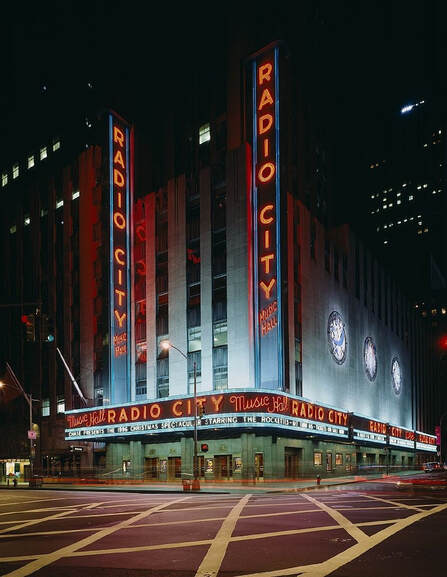 Architect Edward Durell Stone was responsible for the imposing Art Deco exterior. However, it was the building’s interior that captivated audiences, both then and now. Designer Donald Deskey, who at the time was relatively unknown, provided the interior decor. The unlikely but inspired choice of Deskey resulted in the stunning entertainment palace we know today. On that opening night in 1932, Deskey’s work thrilled audiences, particularly in contrast to the lackluster show that evening. One critic wrote that the building itself was so magnificent that it did not even require performers. Deskey’s Art Deco esthetic choices focused on bringing clean lines, structural ornamentation, and a European Modernist sense to the design. Attendees first passed inside the building’s elegant lobby, then filed into the Grand Foyer. They could also enjoy eight distinct lounges with smoking areas. Each of these was created with a specific theme referring to another world culture. The entire building was, in fact, a celebration of humanity’s creativity in multiple fields: the arts, science, and industry. Art was a focal point of the overall design. Deskey worked with expert technicians and craftspeople to fill the building with distinctive wall decor, draperies, carpets, sculpture, and murals. He also employed 20th-century innovations in technology in the form of industrial materials such as aluminum and Bakelite, which for seamlessly integrated with stone- and woodwork, gold foil, and marble. Design enthusiasts continue to thrill to Radio City’s interior tactile richness, the variations in tone and color, and the vast interior spaces filled with sweeping, intricately lit arches that evoke the feeling of a sunset overhead. 6. It was constructed with the audience in mind. Radio City’s grandeur covers a lot of space. Its auditorium stretches 160 feet from the stage to the rear. Its ceiling soars more than 80 feet high, and its marquee spans an entire city block. There’s not a bad seat in the house, thanks to Deskey and his design team. A series of shallowly-constructed mezzanines are arranged in such a way that they don’t obstruct the orchestra section below them. Additionally, no columns block the ability to see the stage. The famous “Mighty Wurlitzer” organ was custom-built for Radio City’s theater. It has so many pipes—ranging in size from only a few inches to some 32 feet long—that it takes 11 rooms to contain its many sections. 7. Its stage is state-of-the-art.For performers and audiences alike, one of the central marvels of Radio City is its ingenious and technologically-advanced set of three hydraulically-powered stage risers. Radio City’s stage has won praise from theater experts and is still considered one of the most advanced and best-fitted-out stage spaces in the world. An additional elevator-riser allows technicians to shift the whole orchestra section up or down. A turntable provides the flexibility of making quick scene changes while supporting numerous possibilities for special effects like fog, rain, clouds, and spraying fountains. 8. It has premiered hundreds of movies over the years.Within two weeks of its opening night, Radio City hosted its first feature film, The Bitter Tea of General Yen, directed by Frank Capra and starring Barbara Stanwyck. It wasn’t long until a premiere at Radio City was the best way to ensure a movie’s success across the nation. Over the succeeding decades, some 700 movies have debuted at Radio City. These include King Kong in 1933, National Velvet (starring Elizabeth Taylor) in 1944, White Christmas in 1954, Breakfast at Tiffany’s in 1961, and Disney’s original Lion King in 1994. In 1962, To Kill a Mockingbird also premiered at Radio City, the same theater where the film’s star, Gregory Peck, had ushered as a young aspiring actor. 9. It is has been home to the Rockettes since its opening.Then there are the Rockettes. Previously known, among other names, as the Missouri Rockets, the all-female precision-dancing, super-high-kicking troupe got its start in the 1920s. The group landed in New York after a nationwide tour just as Radio City was preparing to open.
Discovered by none other than “Roxy” Rothafel, the Rockettes opened the first evening’s performance at Radio City Music Hall, and have been its most iconic performers ever since. In the late 1970s, when financial problems almost forced its closing, Radio City was buoyed back up on a wave of nationwide support led, in part, by the Rockettes. Although in the segregated 1930s, the Rockettes’ line-up was all-white, today’s Rockettes are moving toward embracing the full range of American diversity and talent. Most recently, the 2019 Christmas Spectacular show saw several new dancers of color joining the team, as well as a “differently-abled” dancer. Music is not only a creative art—it serves as a source of inspiration for human imagination, creativity, and insight into a wide range of other fields. With problem-solving skills and the creative insights that come along with “divergent” thinking increasingly recognized as key to higher-level professional accomplishment, productivity, and personal fulfillment, teachers, parents, and employers are looking to music to help young people develop these habits of mind. Here are only a few notes on what science, art, and psychological research have to say about music’s ability to inspire creativity: Ratiocination through musicSherlock Holmes, the fictional detective invented by Sir Arthur Conan Doyle in Victorian-era England, famously found relaxation and renewed focus (i.e., ratiocination) to tackle his most difficult problems through playing the violin or listening to music. Doyle also often depicted Holmes as rushing off to enjoy an opera after finishing a particularly challenging case. Seeing farther through musical imagesDid you know that Albert Einstein was an accomplished violinist and pianist? He credited his love of music as a major inspiration for his scientific insights, and he is known to have commented that had he not chosen a career in physics, he would have become a musician. In fact, Einstein attributed his ability to discover previously unknown mechanisms behind the workings of the universe to the inspiration and intuition that he gained from music. He once told the Czech psychologist Max Wertheimer, one of the founders of Gestalt psychology, that he thought in images and emotions and often built out his scientific and mathematical ideas within a type of mental musical architecture. (Wertheimer himself was an accomplished violinist and composer.) A paint box filled with musicThe early 20th-century Russian painter Wassily Kandinsky is only one of the many artists who tried in his compositions to present a visual counterpart to a piece of music. Kandinsky had synesthesia, a neurological condition in which a person processes information and experience through multiple senses simultaneously (for example, “seeing” sound and “hearing” color). Kandinsky drew inspiration for a number of his works from musical pieces such as Richard Wagner’s Lohengrin. After hearing the opera, Kandinsky created Composition 8, a painting that makes use of shape and color in an attempt to create a feeling in the viewer similar to that evoked when listening to music. Meaningful wanderingsSome experts have pointed to music’s capacity to induce a state of “mind wandering” as one of the reasons for its creativity-boosting powers. When we listen to music, we are no longer mentally confined to our immediate environment. Our minds are more likely to play and to agglomerate ideas, memories, and images that were previously stored in separate conceptual boxes. We are also more apt to fall into a state of reverie, in which our imaginations take flight without being exposed to the judgments of others. Research supports music as a creative sparkA study published in 2017 found music to be a powerful inspiration for creativity. Earlier research had already proven music’s strong role in enhancing intellectual performance, memory, and our all-around ability to learn new information. In this particular study, test subjects went through exercises that attempted to gauge their degree of convergent or divergent thinking as they sat in either a completely silent environment or in one where they could hear classical music that encouraged one of four different emotional states. The psychologists conducting the research project defined “divergent thinking” as the ability to generate more distinct ideas, as well as greater numbers of unusual and creative ideas, in pursuit of a solution to a problem. The researchers looked at comparisons of their subjects’ performance on both types of thinking across the five possible sound environments. They discovered that test subjects who did the exercise while listening to upbeat, joyful music performed measurably better in their capacity for divergent thinking than those who had been tested in a silent room. The three other types of music—sorrowful, anxious, and calming—did not produce a noticeable increase in divergent thinking as opposed to the silent room. The conclusion: When people listen to happy, uplifting music, their performance on tasks requiring divergent thinking and creativity trends significantly upward. The researchers stated that this type of music likely makes cognitive function nimbler and more pliable, resulting in the ability to “see” multiple innovative possibilities. The test subjects who listened to “happy” music seemed to gain in the type of mental flexibility that allowed them to move quickly and easily from one viewpoint or idea to another. They were also less apt to become bogged down in less-useful perspectives. One interesting side-note: Whether or not the test subjects enjoyed the particular “happy” music they heard did not seem to have any influence on their ultimate ability to display divergent thinking in their task performance. This finding suggests that the cognitive benefits they attained had nothing to do with their own emotions at the time. (Incidentally, none of the four types of music seemed to enhance participants’ convergent thinking, the ability to simply find the “correct” answer to a problem.) The researchers in this case also speculated that the sheer act of listening to happy-sounding music created an optimistic, playful frame of mind in their test subjects, one that allowed them to experience positive feelings about exploring, learning, and problem solving. This idea is in line with other research that suggests strong linkages between a positive attitude and creativity. Music uplifts everyone’s creativityA steady stream of psychologists, scientists, and artists have published essays and books describing the many ways in which some of the most accomplished creative minds throughout history have drawn inspiration from music. Some experts on the subject even believe that regular immersion into listening to or performing music might be able to help almost anyone achieve Einstein levels of intellectual and creative power.
Music therapy has long been recognized as a way to help patients heal from trauma. Music-focused therapy offers multiple benefits: it can foster positive social relationships, reduce feelings of anxiety, modulate the intensity of emotionally fraught memories, and bring about emotional catharsis as patients work through painful events. Music therapists have assisted people who have experienced some of the most terrifying natural disasters and terror attacks in recent history. For instance, therapists have brought the healing powers of music to survivors of 9/11, Hurricane Katrina in 2005, mass shootings, and war and conflict zones around the world. A tested healing profession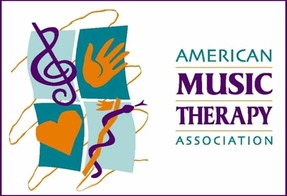 The American Music Therapy Association (AMTA) offers a concise definition of its field: Music therapy is anchored in clinically verified and evidence-based practices designed to help patients achieve their therapeutic goals in collaboration with professionals credentialed through an approved music therapy program. A professional qualified in music therapy can assist clients in a variety of settings, including private practice, public hospitals, mental health clinics, substance abuse treatment facilities, and more. A century-old treatment for trauma Music therapy as a means of healing after trauma first gained currency in the United States after American physicians began treating soldiers who developed post-traumatic stress disorder (PTSD) during service in the First World War. Today, music therapy and its practitioners are part of a well-established medical and psychiatric tradition. Building multiple types of resilienceMusic therapy is not a “cure” for the aftermath of trauma, but it can help patients of all ages strengthen their understanding of their emotions and acquire positive skills for coping with long-term symptoms. The AMTA’s principal findings on the efficacy of music therapy note that it can be effective in strengthening patients’ ability to function successfully in terms of their emotions, reasoning capacity, relationships, and overall behavior. When successfully practiced, music therapy can also ease muscle tension, and it can be conducive to promoting greater relaxation and increased openness in interpersonal relationships. Going where words cannot For people who have experienced trauma, music can provide a deeply important means of communicating what they urgently need to express—without words. Music therapists often point out that their patients need to be reassured that the often-overpowering emotions they may feel in response to trauma are normal and valid. Patients also sometimes need “permission” to explore what are often threatening or negative emotions surrounding the events of their trauma, in a safe environment. Music therapy has shown the ability to provide a wordless way for patients to express fraught or uncomfortable emotions about traumatic experiences. The non-invasive, non-judgmental aspect of music therapy is particularly important to note here. Patients can pour their feelings into listening to or performing highly expressive, artistic creations without fear of the negative reactions or judgments of others. While talk therapies are often very helpful to patients, experts point out that music therapy offers the advantage of providing clients with a quick resource for tapping into previously ignored or threatening feelings and memories. In certain instances, music therapy has even been shown to lead to shorter inpatient stays and a better fulfillment of clients' larger goals for treatment. Increasing confidence and control Music therapy can also help patients to feel more in control of their own emotions and can give their self-confidence and feeling of personal empowerment a much-needed boost. For people who have undergone traumatic experiences, this is especially needed. Many people who have been traumatized feel confused, bewildered, and powerless. They may feel as though life has become chaotic and that nothing—and no one—can be trusted. Healing relationshipsIn addition, music therapy can assist people in reconnecting with their loved ones in positive ways, reestablishing bonds of intimacy that may have been strained or broken under the strain of the trauma. Easing stressStress reduction is perhaps one of the most meaningful and most studied benefits of music therapy. According to the American Psychological Association, a study of pre-term babies in a neonatal intensive care unit suggested that lullabies may have the power to soothe infants and their parents, who find themselves in the midst of a bewildering array of medically necessary, but intrusive and noisy machinery. The researchers in this 2013 study also surmised that the soothing music might have the ability to regulate the babies’ sleep habits.
Interestingly, of all the methods of delivering the music to the babies, singing was the most effective at slowing their heart rates and lengthening the amount of time they remained in a state of calm alertness. According to the study’s lead author, live music in particular shows the most potential to appropriately stimulate and activate the human body, elevate a patient’s quality of life, and promote recovery. If you’re a music educator, you may have encountered a student or two who showed signs of musical giftedness, but perhaps you struggled with how to address the special needs that accompany all that talent. While working with a highly gifted student presents some challenges, it can also be one of the most rewarding experiences of your career. Whatever goals and challenges come along with working with a gifted student, a music teacher could not find a better role model to study than Dorothy DeLay, the 20th-century violin teacher whose life, career, and teaching methods have become renowned all over the world. A legend during her lifetime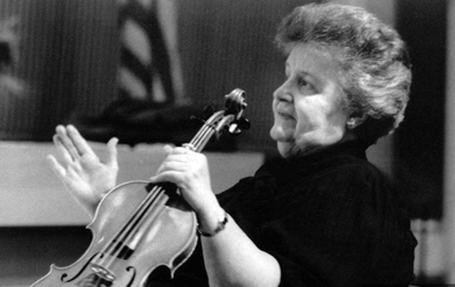 Dorothy DeLay’s approach to teaching music continues to be frequently cited and praised by experts. DeLay, who died at age 84 in 2002, taught a roster of notable pupils, including Itzhak Perlman, Sarah Chang, Kyung-Wha Chung, Nigel Kennedy, and Midori. DeLay’s reputation was such that any pupil she accepted could with some degree of confidence expect to enjoy a distinguished career. Her connections among talent agents were well-known, and often, families of talented musicians went out of their way to persuade her to accept their children into her program. She also had an encyclopedic knowledge of the way the music and performance worlds functioned, and she was a master of understanding what did and did not work on the concert stage. The greater part of DeLay’s teaching took place at The Juilliard School in New York City, although in the summer she traveled to work at the Aspen Music Festival and School in Colorado, as well as at other venues throughout New England. An unconventional nurturing of talentDeLay, who was a student of psychology, strongly believed in developing a musician’s inner powers of concentration and attitude through a focus on gentle but consistent encouragement of individual strengths. This may have been particularly important to her because she herself had many teachers and musicians in her family. Experienced teachers today who have learned from her methods emphasize the point that timing is everything. Working with gifted students in a music program centers on a delicate balance of educating them as much as possible as early as possible while guarding against creating a program so intense that it becomes self-defeating—or even physically or emotionally detrimental. DeLay would often recommend to her students books on mental focus, such as The Inner Game of Tennis: The Classic Guide to the Mental Side of Peak Performance by W. Timothy Gallwey. The tennis pro’s now-classic self-help book has helped people make positive changes in their lives far beyond the world of sports. Gallwey’s instructions for overcoming the self-doubts, equivocations, and fears that can destroy even the most talented person’s performance have had a lasting influence in business and the arts as well. Applying Gallwey’s wisdom to teaching the violin, DeLay encouraged her students to become their own coaches and teachers, working through their problems themselves. DeLay would also take pains to ensure that each of her pupils engaged in a range of other activities beyond studying their individual instruments. And even with her softer, looser style, DeLay did require her students to put in plenty of hours dedicated to their craft. She believed in giving her students her best, in order to help them become their best. A gifted student who understood other gifted studentsDorothy DeLay was born in Medicine Lodge, Kansas, in 1917. She was a gifted child herself, learning to read at the age of 3. She became an excellent violinist by the age of 4 and performed in a local concert at age 5. She entered the Oberlin Conservatory of Music in Ohio at 16, and later matriculated at Michigan State University, fulfilling her parents’ wishes that she obtain a more wide-ranging education. As a student at Juilliard, DeLay studied with, among others, Louis Persinger, who was the first teacher of legendary violinist Yehudi Menuhin. However, she decided that performing was not for her—she felt she was simply too shy and too anxious about the quality of her performance. Marriage, motherhood, and teachingIn 1941, DeLay married journalist Edward Newhouse, with whom she would have two children. She returned to Juilliard a few years later to become a teaching assistant to her old instructor, the revered Ivan Galamian, while still in her early 30s. She would soon become Galamian’s chief assistant. Feuding methodologiesDeLay eventually came to disagree with Galamian’s teaching methods. In 1971, she created her own series of classes at the school, and students were forced to choose between her or Galamian. Perlman was among the students who transferred from Galamian to DeLay. This put the finishing touch on a life-long breach between the two great teachers that began when DeLay transferred her teaching outside Juilliard to Aspen, rather than continuing at Galamian’s Meadowmount program. According to former students, there could not have been a greater contrast than that between the motherly, nurturing DeLay—she often called her pupils “sugar plum”—and the more iron-handed Galamian. Still, DeLay expressed respect for Galamian, even long after their feud had set in. Displaying her trademark psychological insight and sensitivity, she remarked that he came from a traditional Armenian background in which the father of the family delivered the word of law. She noted that dignity was, for him, a prime requirement, and spoke admiringly of how he worked to create a dignified, no-nonsense atmosphere in his classroom. Earning her laurelsBy the 1980s, DeLay had achieved her own international acclaim as a teacher. Her master classes were eagerly sought after by students from around the world. She received numerous awards, including the first-ever National Medal of Arts awarded to a teacher, which she earned in 1994. The following year, the National Music Council presented her with its American Eagle Award. Documenting geniusDorothy DeLay believed in teaching students, not just subjects. In 2000, author Barbara Lourie Sand published Teaching Genius: Dorothy DeLay and the Making of a Musician, her book-length study of DeLay and her methods.
Much like The Inner Game of Tennis, Teaching Genius details DeLay’s technique of nurturing her students’ inner focus, as well as her gentle encouragement. The book shows how she worked to build students up and empower them with the knowledge that their talent mattered and that they could translate musical ideas into empowering experiences for their audiences. The music world remains in her debt. Choral music has held a revered and beloved place in human societies since the beginning of recorded history. From medieval times to today’s children’s choirs, here are four things you need to know about choral music: 1. Choral music has its roots in religious music.Most of today’s choral singing groups can trace the roots of their practices back to sacred music. The most popular example is probably the Gregorian chant that was a familiar part of medieval church services. In Gregorian chant, groups of monks would participate together in singing the various passages of sacred music. The conscious blending of their individual voices created the powerful sound of a single musical presence. It still serves as the model for much modern-day choral music. Gregorian chant, a form of the monophonic “plainsong” or “plain chant,” accompanied the recitation of the mass and the divine office of the canonical hours. It derives its name from the fact that it developed during the rule of Pope (later Saint) Gregory I, at the turn of the 7th century of the Common Era. The development of polyphony, the use of more than one voice or tone heard in a composition, brought composers the opportunity to expand on the range and types of compositions they wrote. When creating contrasting vocal parts, composers often drew on the talents of young boy sopranos to sing the contrasting trouble notes. This is because during this period in history, women’s voices were often forbidden in public performance. 2. Choral music eventually found a secular audience and begin to include lyrics and instruments. As religious reformation and social secularization progressed, audiences outside sacred spaces enjoyed greater opportunities to hear choral music in performance. Once it flowed outside the monasteries and into the streets, its composers experienced greater creative freedom. They began to abandon the formalized structures common to sacred choral music, and to add instruments into the mix. Composers also began to bring in human voices singing in chorus to enhance and add texture to familiar types of instrumental pieces. The addition of words enabled composers of instrumental music to address their audiences in new ways. The Baroque period saw Italian composer and singer Claudio Monteverdi creating “polychoral” sacred pieces with multiple choirs and increasing numbers of instruments. The 16th and 17th century choral tradition also included the development of numerous motets, a form that evolved during the Middle Ages into a variety of types of religious and secular compositions. 3. Choral music was integrated into the oratorio and symphonic traditions.The oratorio, a larger composition for orchestra, chorus, and soloists and typically based on stories from scripture, was born as composers expanded on the form of the motet. The oratorio form reached its apogee during the 1600s. The German composer George Frideric Handel, who worked extensively in England, perfected this type of music. Handel became, in fact, the father of the particularly English style of oratorio. One exceptional 19th-century example of the integration of choral music into the symphony is the “Ode to Joy” sequence of the 1824 Ninth Symphony of Ludwig van Beethoven. The large-scale choir’s singing of text by the lyric poet Friedrich Schiller lifts the mood into a soaring affirmation of humanity’s potential. For many lovers of classical music, Gustav Mahler’s use of choral performance in his titanic symphonies represents the pinnacle of the form. Mahler’s Second “Resurrection” Symphony, as well as his Third and his Eighth, offer powerful musical interpretations of the nature of love, life, and fate enhanced by the voices of their choruses. The Austrian composer, whose creative period straddled the 19th and 20th centuries, became known for his thundering, multi-layered sound. His Eighth Symphony earned the title of “Symphony of a Thousand” thanks to its gargantuan cast of voices and instruments. It is written for performance by a massive orchestra, a double chorus, a boys’ choir, and eight single solo voices. 4. Today, children's choral groups continue to delight performers and audience members alike.Today, choral music in the United States continues to flourish, performed by a wide range of ensembles of all ages. Children’s choruses offer opportunities for young people to engage with music education, learn performance skills, and develop friendships based on a common commitment to creative work.
The Children’s Chorus of Washington is one group that represents the nation’s capital. Over the past 24 years, it has provided choral training and experiences to 2,500 youth and toured internationally. The Children’s Chorus of Greater Dallas is a mosaic of six individual groups of some 450 singers total. Under the auspices of the Deloitte Concert Series, it performs seasonal concerts at the Morton H. Meyerson Symphony Center. The Boston Children’s Chorus is composed of about 500 students from all over the greater Boston area. Almost half of them live in the city of Boston. Children’s choruses typically hold auditions at designated times of year, and work hard to open opportunities to as many talented young people as possible. The BCC’s students, like those in Washington DC, Dallas, and many more communities around the country, are eligible to receive need-based scholarships to support their participation. In fact, about 80 percent of the BCC’s performers attend its musicianship programs on scholarship. Teaching children to sing and play their country's national anthem—and those of other nations—can be a fun, effective musical lesson. National anthems can also serve as an effective means of connection between the arts and studies in geography and culture, at a time when educators are realizing the value of helping students build bridges between subjects. Enriching the music curriculum through cultural geographyIn units on patriotic songs, teachers have come up with rich curricula on the US national anthem, “The Star-Spangled Banner,” and many other national anthems. Information on some of these is available through the National Association for Music Education (NAfME). The organization offers links to repositories of vocal and instrumental performances of these anthems, as well as sheet music and background summaries on hundreds of current and historic anthems. In addition, several publishers offer engaging books for children explaining the origins and importance of national anthems. Also widely available are books for all ages containing sheet music of the world’s anthems. The book National Anthems from Around the World, prepared by well-known music publisher Hal Leonard, LLC, is just one example. Thanks to the internet, recordings of these anthems in their original languages are only a few clicks away. Several versions are accessible on YouTube and Spotify. Public libraries are another rich—and free—source for streaming versions of the world’s national anthems. Music is a truly universal language. On the other hand, a country’s national anthem presents its people’s viewpoint on their history and their hopes for the future. Let's take a look at a few contemporary national anthems and learn how the stories they tell demonstrate both the diversity and common experiences of the world’s peoples. A poignant reflection on warWhile it's notoriously difficult to sing well, “The Star-Spangled Banner” had become a time-tested American institution even before it became the country’s official anthem in 1931. President Herbert Hoover signed the congressional resolution declaring the song’s historic status on March 3 of that year. Francis Scott Key famously wrote the words as a poem on September 14, 1814. Key drew inspiration from his sighting of a single American flag still flying over Fort McHenry in Maryland as the fort sustained British bombardment during the War of 1812. Key was an eyewitness to the attack, as he waited on board a ship only a few miles away with the friend he had just helped release from British captivity. Key titled his poem the “Defence of Fort McHenry.” Years later, others set his words to the tune of the English drinking song “To Anacreon in Heaven,” composed by John Stafford Smith. A royal and national hymn that went around the worldThe country from which the United States gained its independence has its own time-honored anthem in “God Save the Queen” (sung as “God Save the King” during the reign of a male monarch). This anthem is also often used throughout the British Commonwealth. The song’s origins are obscure. The Oxford Companion to Music lists several early variants. Some authorities credit Henry Purcell or any of several other 17th century composers. Many music historians cite composer and keyboardist John Bull, who died in 1628, as the song’s likely author. Others point to a passage in an old Scottish carol as remarkably similar to the current version of the anthem. In any case, the earliest known printing of the unattributed lyrics to “God Save the Queen” appeared in 1745. The song soon appeared on the English stage and found its way into the work of composers George Frideric Handel and Ludwig van Beethoven. American composer Samuel F. Smith borrowed the tune for “My Country, ‘Tis of Thee,” which appeared in 1832 and has become an unofficial second national anthem for the US. A paean to the “True North”Canada’s national anthem, “O Canada,” was first publicly performed in 1880. Its title in the original French, as written by Sir Adolphe-Basile Routhier to music by Calixa Lavallée, was “Chant national.” A special government committee approved the song as the country’s national anthem in 1967, and it was officially adopted in 1980. The song’s lyrics celebrate the beauty and strength of this country of the “True North,” and express the hope that, through the help of God and “patriots,” it will remain “glorious and free.” Born in revolutionFrance’s national anthem, the marching song “La Marseillaise,” literally calls citizens to arms in defense of freedom in the fight against tyranny. Amateur composer Claude-Joseph Rouget de Lisle came up with the song overnight in 1792, at the height of the revolution that overthrew the French monarchy. The song’s current popular name arose after troops from the port city of Marseille adopted it as a particular favorite. The beauty of the landSome national anthems focus less on military or sovereign power and more on the natural beauties of the lands they represent. Australia’s national anthem, “Advance Australia Fair,” exalts its people’s home “girt by sea,” with its “beauty rich and rare.” Similarly, the Czech Republic’s national anthem’s title translates literally as “Where Is My Home?” The song’s simple, meditative music and lyrics convey the loveliness of the country’s landscape of pine trees, mountain crags, and flowing streams. A symbol of national reconciliationOther countries’ national anthems focus on their diversity and hard-won unity. South Africa’s national anthem, “Nkosi Sikelel’ iAfrika” is based on a 19th century hymn originally written in Xhosa that later became the anthem of the African National Congress. In the early 1990s, during the dismantling of apartheid, the country declared two national anthems: “Nkosi” and the Afrikaans apartheid-era anthem “Die Stern van Suid-Afrika” (“The Call of South Africa.”)
When the country won the 1995 Rugby World Cup, both songs were sung together. Today, South Africa's national anthem combines shorter versions of both songs into a single national hymn, with lyrics in five languages: Xhosa, Zulu, Sesotho, Afrikaans, and English. When students of any age are learning about music, they will find their studies enriched by learning about the history of different musical forms. The following survey of medieval Western music can serve as one doorway into this topic for young musicians, as well as for adult learners interested in the musical history of Europe. Defining an era beyond the stereotypesThe stereotypical view of anything “medieval” conjures up images of dank, fusty monasteries, brutal warfare, and stagnation in the arts and sciences. However, this is far from the truth. The Middle Ages in Western Europe were years of great creativity in the arts, sciences, and exploration. Authorities differ on which time span precisely defines the Middle Ages. The most generous reckoning begins the period at the fall of the Roman Empire in the late fifth century and ends it in the late 15th century AD. A world centered on prayerThe medieval period was characterized by the central place of liturgical music as both high art and a daily companion for the nobility and common people alike. The practice of singing psalms and setting prayer to music dates back much earlier than the Middle Ages, into the beginnings of human history. While much of this ancient religious music was performed a cappella, instruments often lent their voices to the mix, enhancing the sound. The medieval Christian church took many of its cues from ancient Jewish sacred music, in forbidding the participation of women’s voices after the late sixth century AD and limiting or curtailing instrumentation. In the church, mass was the chief occasion for the performance of this music, sung by priest, congregation, and choir. The choir typically filled an “answering” function, responding to the themes of the main part sung by the priest. The human voice as instrumentThe long tradition of prayer through song reached a pinnacle in the development of Gregorian chant, a variety of plainchant, during the ninth century AD. Gregorian chant is still often used today in Catholic ritual. This style of plainchant puts the religious text at the heart of the composition. The human voice is the only instrument used. The music of Gregorian chant is described as monophonic—it consists of one melody, sung in unison. The chant serves to frame the words of the prayers, rather than to overpower them. The majority of Gregorian chants originate in the Latin Vulgate, the version of the Bible in widespread use in medieval Europe. Although most Catholic congregations today celebrate mass in the community's vernacular language, traditional Gregorian chant holds an honored place, both esthetically and liturgically, in modern Catholic culture. Its popularity with both religious and secular audiences is attested by the many recordings now available. Hildegard von Bingen – a composer of mystic devotionHildegard von Bingen, later Saint Hildegard, was born in Germany at the close of the 11th century and died near the end of the 12th. This abbess, mystic, and prophetic visionary is considered one of the first and most talented female composers. Her monophonic works are characterized by soaring lyricism and a deeply felt spirituality. St. Hildegard set dozens of her own poems to music, assembling them into a collection entitled Symphonia armonie celestium revelationum. She was also a scholar who wrote widely on science and medicine and traveled as an itinerant preacher. Numerous musical ensembles have produced recordings of St. Hildegard’s surviving compositions in recent years, and contemporary audiences continue to find them musically and spiritually rewarding. Contemporary collections of her music have titles that reflect her mysticism: Canticle of Ecstasy, Music for Paradise, and A Feather on the Breath of God are only a few examples. Moniot d’Arras – exemplar of the trouvère estheticOne enduring tradition that flourished particularly in the later Middle Ages was that of the secular romantic balladeers and traveling entertainers known as troubadours and trouvères. Lutes, citterns, and other stringed instruments frequently accompanied these musicians' compositions, although their vocals often stood alone. The city of Arras, France, in northern France was noted as a center of the delicate and refined trouvère style. The trouvères’ style evolved roughly in tandem with that of the troubadours, although the trouvères typically composed lyrics in their northern French dialect, and the troubadours drew from the vernacular native to southern France, the langue d’Oc. One monk, Moniot d’Arras, earned widespread recognition as a composer in the early 13th century. While much of his output was focused on liturgy, many other pieces extol the culture of chivalry and courtly love between a nobleman and his lady. These were often the main subjects of troubadour and trouvère compositions. The sacred and the secularThe traditions of the troubadours and trouvères were part of the larger growth of non-sacred medieval music from about the 13th century onward. The ballade, the rondeau, and the virelai were the three leading types of secular compositions in France at this time. Guillaume de Machaut – lyricist supremeGuillaume de Machaut, considered today one of the towering figures of medieval European music, was born at the beginning of the 14th century and is thought to have lived well into his 70s. He wrote in both French and Latin.
Machaut composed one of the first polyphonic treatments of the mass, a development moving away from the monophonic plainchants. Polyphonic music features two or more independent melodies. Machaut's dozens of motets demonstrate the full flowering of this type of music. In 1337, Machaut became the canon of the cathedral at Reims. He wrote poems and musical compositions, with experts today viewing him as a master lyricist and versifier working in the then-current Ars Nova (polyphonic) style. Machaut also used and reworked the courtly love theme, creating beautifully constructed poems that blend technical virtuosity with lyricism. |
Photo used under Creative Commons from Marina K Caprara
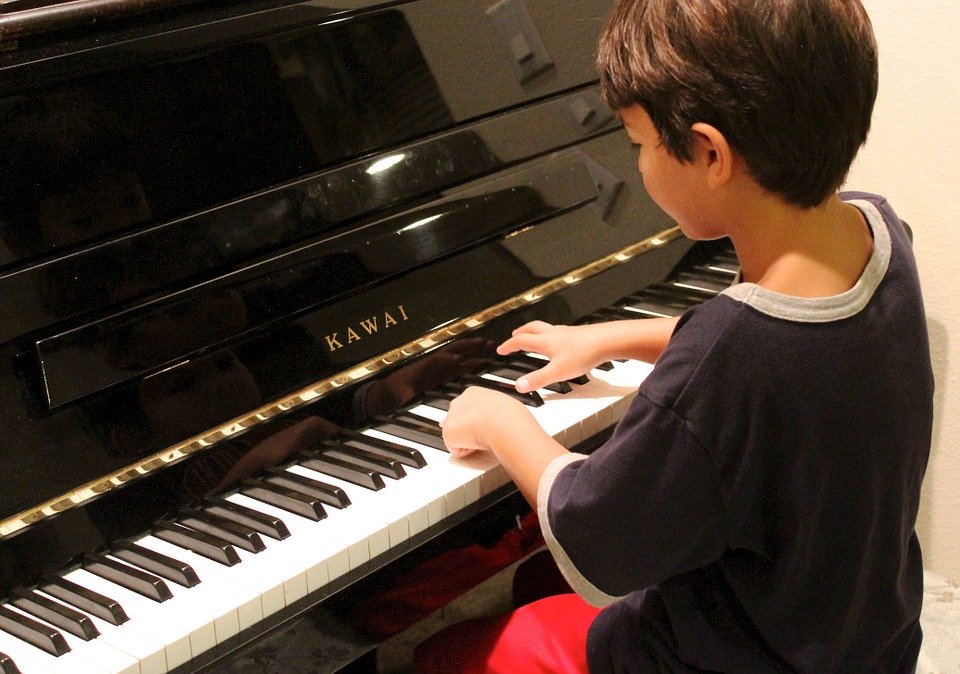

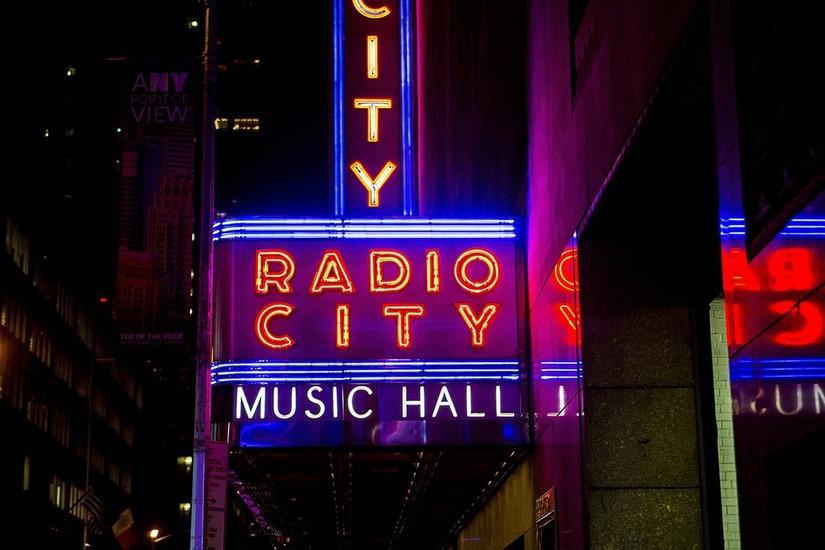

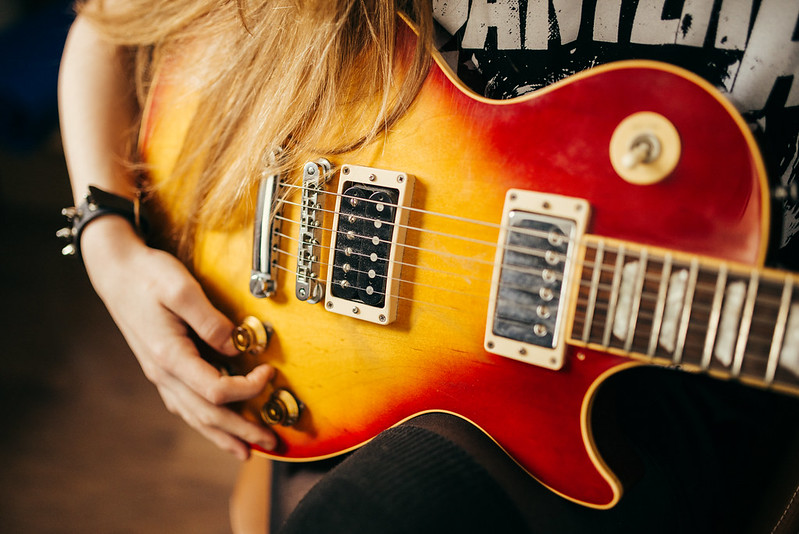
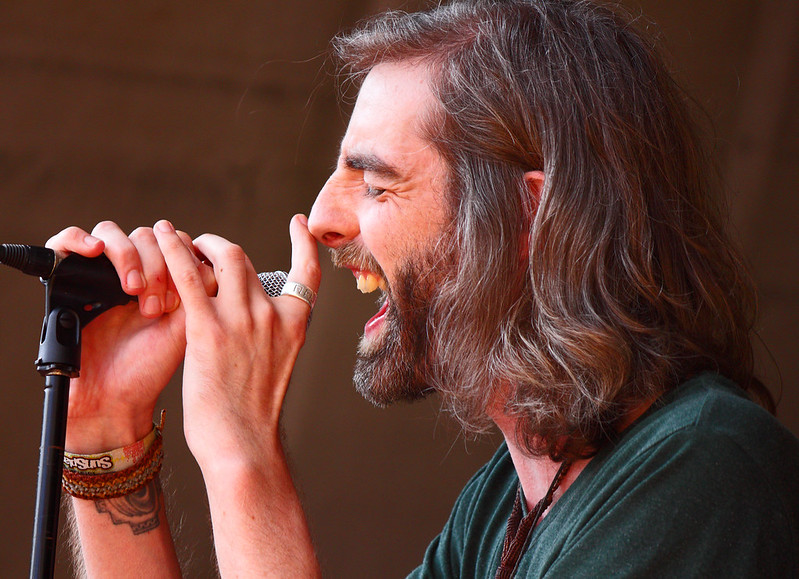
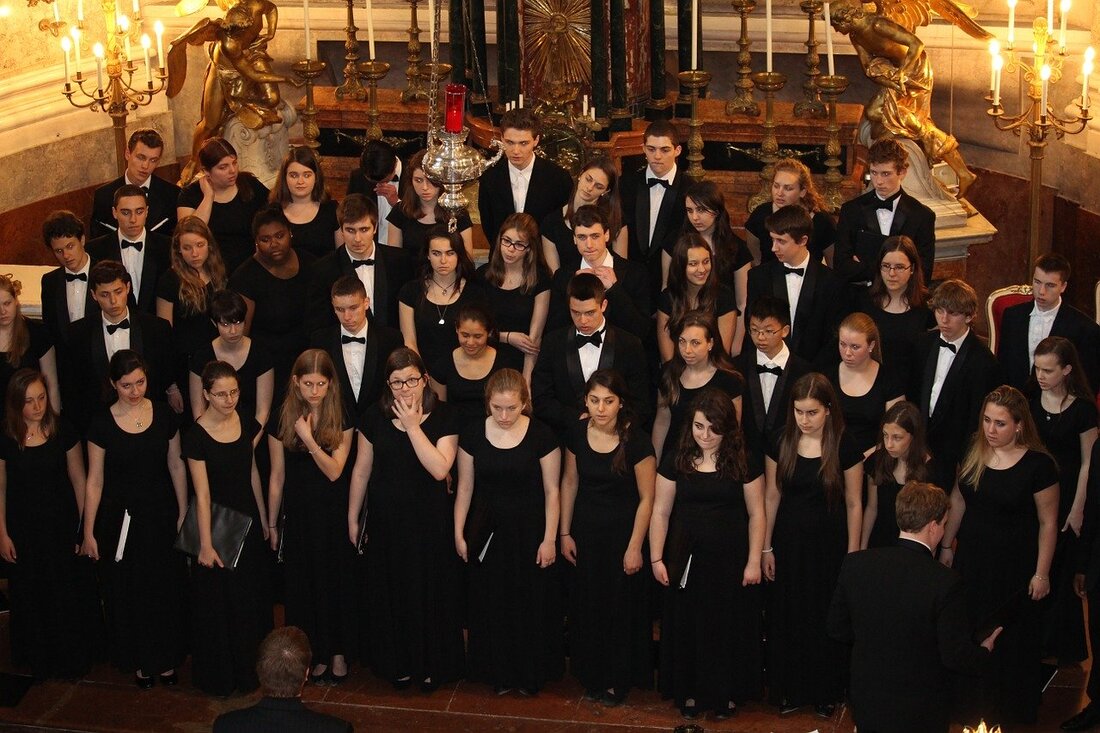


 RSS Feed
RSS Feed
